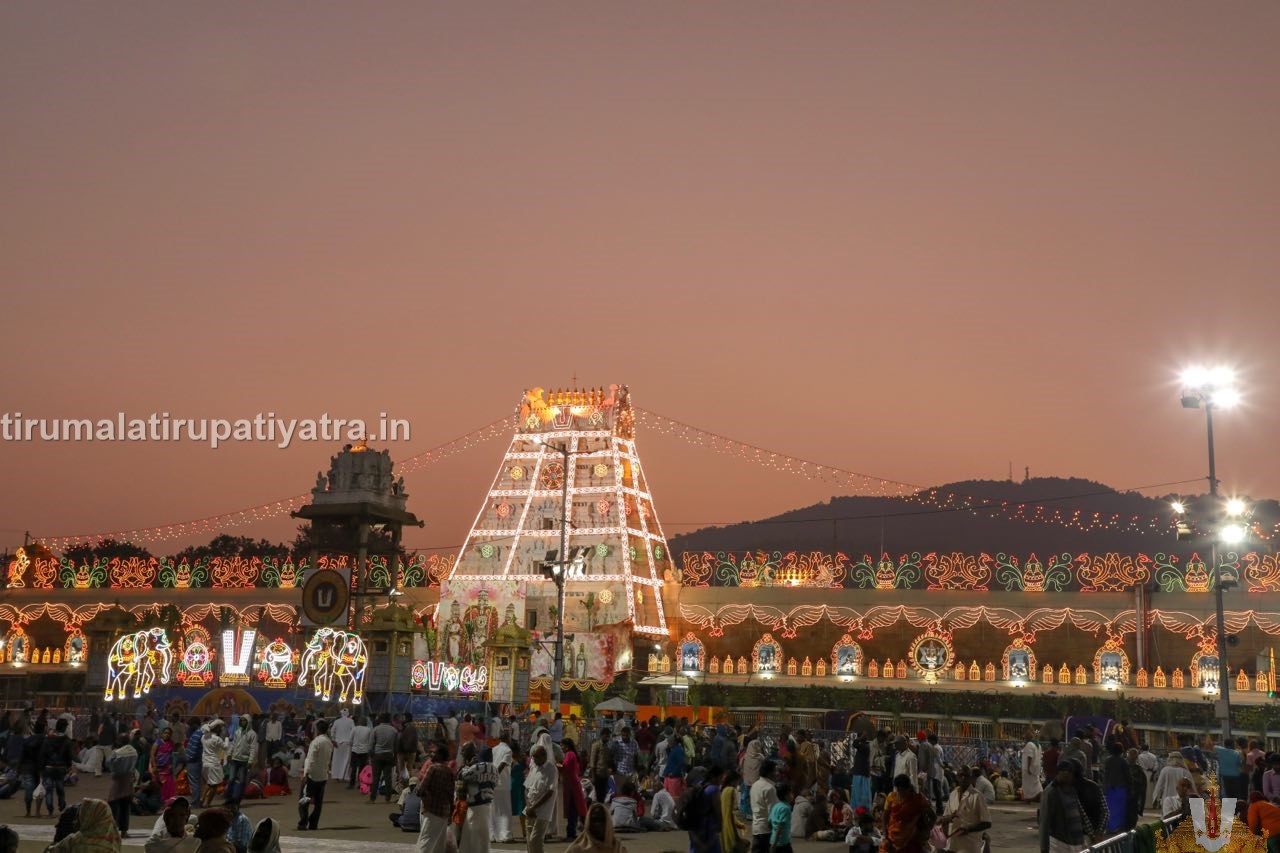Tirupati Balaji
The main Deity famously known as Tirupati Balaji is also termed mula virat (Moola Virat), Dhruva Murthy, Dhruva Beram, and Mula beram. (moola beram). This idol of Salagrama stone self-manifestation of the Lord wearing a disc and conch in the sanctum sanctorum of Ananda Nilaya. It is about 8 feet high.
The Dhruvabera of Lord Venkateswara and the complementary bronzes, with the Utsava murtis of Sri Rama and Sri Krishna, make up the pantheon of Tirumala.
The idol of Lord Venkateswara at Tirumala is seen to be a standing one which makes it fall only under the sthanaka type. Hence a sthanaka image, according to the Agamas, can be of the Yoga, Bhoga, Vira, or Abhicharika type, each of which would have three sub-types namely Uttama, Madhyama, and Adhama murtis. (Check the heading – “The Agamic rule for making a deity for details).
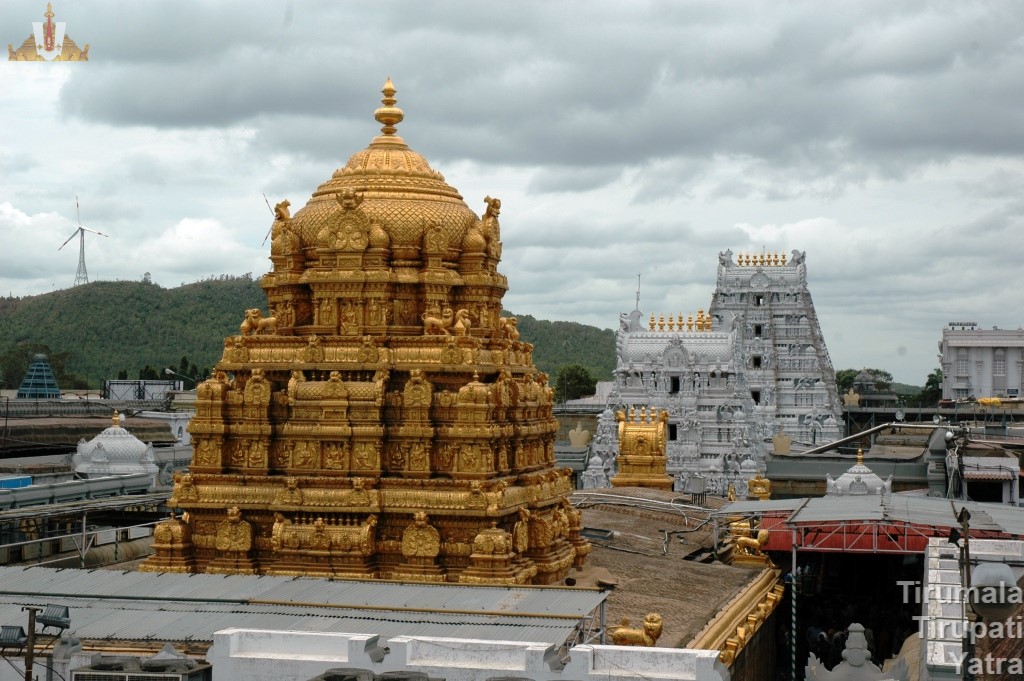
The Idol of Lord Venkateswara and other murtis in the Tirumala Temple
A Hindu temple is always conceived as a miniature universe revolving around the creator who is represented by the presiding deity within the garbhagriha. Hence the temple precincts normally display all the various facets of the universe like the animals, trees and planets, human beings and their various forms, demi gods, kinnaras, gandharvas, the nadi devatas, the vana devatas, etc.
Hence in a Hindu temple, almost all the aspects of the panorama of life with its variegated changing patterns are represented in the sculptured panels. The temple of Tirumala is no exception to this rule. Since in a Vishnu temple, the major theme is the various forms and avatars of Lord Vishnu, these have repeatedly been shown in the sculptures of this temple.
Various forms of Narasimha, well-known scenes from the Ramayana, the Krishna Leela scenes, scenes from the legends connected with the Dashavataras, and a host of other connected Vaishnava themes and legends, are all represented in the sculptures of the various pillars of the Tirumala temple.
Among the various forms of Vishnu, Narasimha, and Varaha became extremely popular under the Guptas, the Cholas, the Pallavas, and other dynasties and this tradition has continued right till today. Hence at the Tirumala temple, there is a separate shrine for the Varaha avatar, which is also called Gnanappiran by the great Vaishnavite Alvar teachers.
There are separate shrines for Yoga Narasimha at Tirumala and for Laxmi Narasimha at Alvar Tirtham. These forms are also repeatedly found as vimana devatas and gopura devatas per the rules laid down in the Agamas.
Similarly, the Ramayana story which has influenced Indian life and culture for well over 2000 years, is also well represented in this temple. There are separate shrines for the utsava murtis of Rama, Laxmana, and Sita at Tirumala. During the Vijayanagara period, bhakti towards Hanuman reached a new height. This Lord became so popular that he came to be worshipped as Panchamukha Hanuman and these are also represented in the sculptures of the Govindarajaswamy temple.
If any one particular Vaishnavite theme or legend can be said to be the most dominating and popular in the Tirumala temple, it is the story of Krishna as depicted in the Bhagavata. The legends connected with the Krishna avatar provide as much scope for the sculptor as for the poet. Rural scenes like the living quarters of the shepherds, the day-to-day life of gopikas, the milking of cow or churning of buttermilk, and playful scenes of the Lord as a child, are all depicted true to the popular Indian tradition and culture of a rural atmosphere.
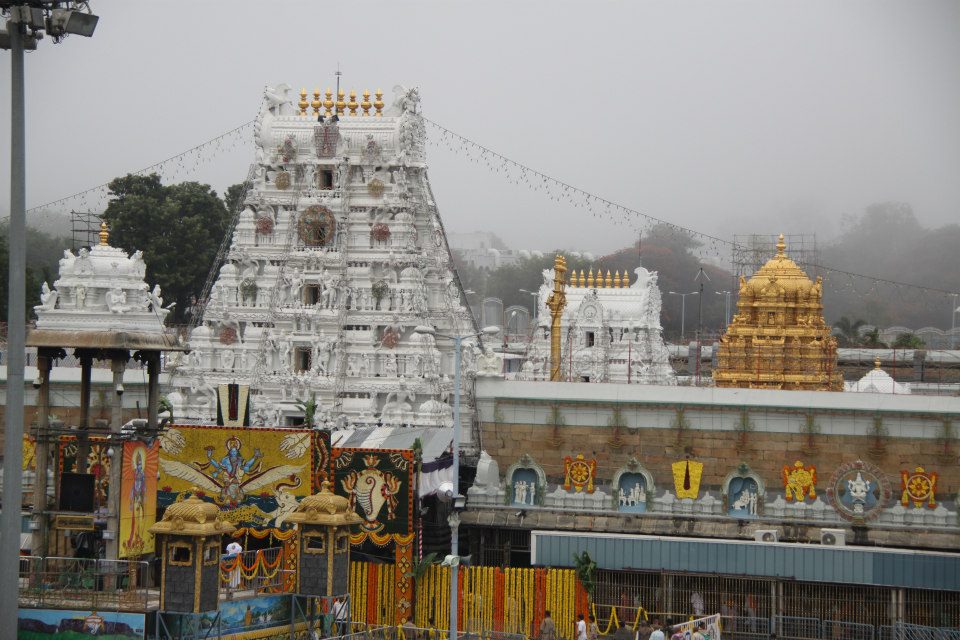
Other agamic aspects of Lord Vishnu, such as Hayagriva, Adimurti, Varadaraja, and Srinivasa are also well represented. The holy weapon of the Lord, Chakra is worshipped in a separate shrine as Sudarshana chakra, and some powerful representations of this are found at Tirumala.
Also per Sri Vaishnava tenets, great importance is given to Sri or Laxmi in this temple. According to Ramanuja who laid down the basic tenets of Vaishnava worship, which are known as Sri Vaishnavism or Sri Sampradaya, Sri or Laxmi is the Supreme goddess who pleads like a mother with the Lord of the universe to shower his grace on his devotees, since she being the universal mother, is the very embodiment of compassion.
This aspect of the mother, and the reverence and affection with which she is held by the devotees, is brought out in the well-known suprabhatham of which one verse is given below:
“O’ Mother of all the worlds! You dwell permanently at the Vaksha-sthala of Lord Vishnu who destroyed the demons Madhu and Kaitapa;
you are the beloved of supreme Lord Venkateswara;
You with effulgent divine beauty are our eternal mother;
You grant all the wishes of your devotees;
O’ supreme consort of the supreme Lord Venkateswara, may the awakening (suprabhatam) be an auspicious one to you.”
Another peculiarity of Sri Vaishnava temples is the existence of a separate place of worship and honor for the alvars and the acharyas of whom the famous saint Andal is one. There is a temple of Andal in the Govindaraja Swamy temple.
The Amuktamalyada of Krishnadevaraya pays special homage to her. Her soul-stirring compositions of Tiruppavai are still sung every day in the shrine of Tirumala. Her divine marriage with the Lord of the universe is an important festival held on Panguniuttiram day.
Divya Suris – Divya Prabhandas
The saints of Sri Vaishnava tradition are called divya suris. Their compositions are divyaprabhandas and the places prescribed by them are divya desas. Tirumala is a divyadesa since all the saints have poured out the devotion of their hearts in exquisite poetry to the Lord of Vengadam.
In the Tirumala temple, though there are no separate shrines to them, they are all represented by sculptures on the pillars, and their hymns are also regularly sung. In consonance with the tradition of the Ramanuja school of thought, there is in the temple of Tirumala a shrine for Ramanuja the apostle of Sri Vaishnavism.
Another special feature of Sri Vishnu temples is the importance given to Vishvaksena, Ananta, and Garuda. Vishvaksena whom the Sri Vaishnavites call by the name Senaiyarkon is the custodian of the household of the Lord and occupies an important place in the Acharya parampara line. His icon is found in the temple of Tirumala.
Similarly, Ananta the divine couch of the Lord, and Garuda the divine vahana are constant attendants of the Lord. Sculptures of Garuda can be seen almost everywhere in the temple.
Similarly, sculptures of the ashtadikpalakas like Indra, Varuna, Kubera, Agni etc., vidyadharas, apsaras etc., shankhanidhi and padmanidhi two of the navanidhis of Kubera the Lord of Wealth, kamadhenu, gajendra, simha, hamsa, kalpalatika etc., are all seen in the Tirumala temple.
The sanctity of the temple is so great that it is said that Siddhas and Yogis and Rishis who have attained great spiritual heights, as well as emperors and ordinary folk are present in the temple premises waiting to worship the Lord.
These ideas have been fully brought out in this famous verse of Tiruppan Alvar.
THE DHRUVABERA OF THE IDOL OF LORD VENKATESWARA
Tradition of a self-manifested idol
The Dhruvabera of Lord Venkateswara and the complementary bronzes, with the Utsava murtis of Sri Rama and Sri Krishna, make up the pantheon of Tirumala. Tradition has it that the Druvabera of Lord Venkateswara was not wrought by the hand of man and that the supreme Lord manifested himself in a form that could easily be comprehended by human beings.
Thus we have Nammalvar’s assurances that Param has come down to Tirumala from his Divya Loka out of his own choice for our spiritual benefit. All the earlier alvars have also stated that the devas headed by Brahma daily worship Sri Venkateswara on this hill as we do even now. Sri Ramanuja the great Vaishnava teacher in his mangala sloka of his great work “Sribhashya” lays stress on the great solace of the Lord for the salvation of mankind, and equals Brahma with Srinivasa.
Hence traditional belief is that Sri Venkateswara is self-manifested Brahma come to Tirumala for our salvation.
The Agamic rule for making a deity
The agamas like vaikhanasa agama, the pancharatra agama, the tantras, and vishnu dharmottara, are the basic texts which lay down in precise detail the rules regarding the construction of a temple and the installation of murtis therein. In agamas, the relative proportions of the idol, the posture of the body, the hands, the weapons to be borne by it, and the jewelry to be adorned on it, are all laid down.
If there is the slightest defect in execution or even a minute variation from the prescribed rule, that image would be considered unsuitable for consecration or worship and not used. According to Sukraniti, an image is ideal only when it elevates the lookers onto a higher plane of action and meditation.
- The eyes of images have particular appeal to the devotee, and as such the eyes should be perfect, be speaking satisfaction, and should neither be directed upwards, downwards, or remain closed. According to the Pratima Mana Lakshna, the mouth should be ‘slightly smiling, pleasant and possessed of all good signs’.
- The mouth should also not be sculptured as one that is ‘passionate, impetuous, wrathful, sour, bitter or circular’. Again, according to the Pratima Mana Lakshna, the head sculptured like an umbrella brings prosperity. Eternal prosperity is assured by an image with beautiful lines of eyebrows and forehead.
- The neck has to be conch-like, the body in the posture of a lion, the arms like the trunk of an elephant, and the thighs like the plantain tree.
- A beautiful belly and beautiful feet are symptoms of excellence in any idol.
- Sukraniti also lays down that images should be beautiful.
Considerable freedom was however given in many cases to silpis (a creator of great skill in the manual arts)to carve images while at the same time following the Sastraic principles. They had however to keep in mind that ‘the characteristic of an image is its power of helping forward contemplation and yoga’ while making idols and images.
The agama Maricha Samhita broadly defines the Vishnu image into three types:
- Sthanaka (standing),
- Asana (sitting), and
- Sayana (lying) poses.
Each of these is again divided into four classes depending on the physical and other attitudes of the Lord.
These are
- Yoga,
- Bhoga,
- Vira and
- Abhicharika.
The environment and purpose for which a murti is installed, decide the kind of idol which should be used. If for example, the devotee prefers to follow the yoga marga, a yoga murti would be selected. Such a murti should be installed outside a village, amid forests, on mountain and hilltops, or at the confluence of rivers and on river banks.
It should not be constructed in the heart of a town or village, as such a murti would bring about the destruction of the place.
- A Bhoga Murti should invariably be installed in the heart of a town or village.
- A Vira Murti should be on the outskirts of a village.
- An Abhicharika Murti would be installed in forests, mountains, and fortresses, at the outer limits of a Rashtra, and facing the enemy country.
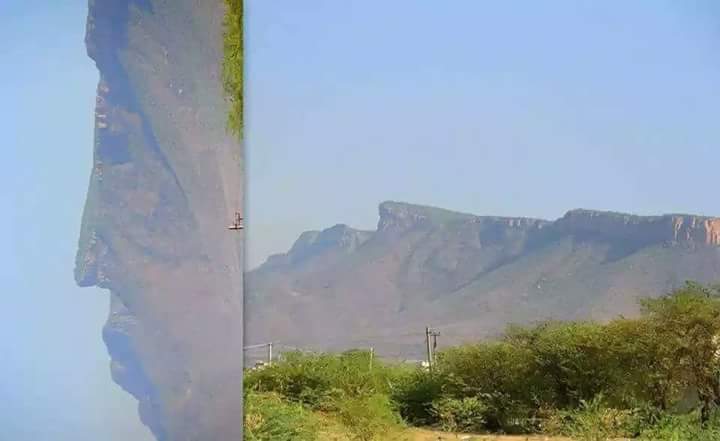
The Tirumala temple is on a hill and in the midst of forests. It does not appear that at any time there was a fortress or a village there. It might perhaps have been politically the boundary line between one country and another. The kind of image chosen would therefore be either Yoga or Abhicharika, and not Vira. Bhoga would be out of consideration. The features of the Murti for each situation and type are also prescribed in the Agamas.
There are three grades of temples depending on the complementary deities.
These are called
- Utthama,
- Madhyama and
- Adhama (best, middling, and low type).
- In the Utthama temple, the Murti would be associated with the complimentary deities, Brahma, Sankara, Markandeya, Bhrigu, Sanaka, Sanandana, Sanatkumara, etc.
- In the Madhyama type Markandeya etc. would be omitted but Brahma and Siva retained.
- In the lowest type Brahma and Siva also would be omitted, leaving the Murti to stand alone.
The above rule governs the installation of Yoga, Bhoga, and Vira Murtis alike. In the case of an Abhicharika Murti. However, there is only one type, the Adhama type, and therefore, the principal Murti alone would be installed.
Further, in the former types the temple would have Vimanams and the consecration would be on an all-auspicious day in Sthira Lagna (at any rate not in a chara lagna). For the Abhicharika Murti, the installation should be at an inauspicious moment and in Chara Lagna. The temple should not have a Vimanam.
General features of an idol of Vishnu
Vishnu images have usually four arms, the ayudhas or weapons held in the hands are the Chakra, Sankha or conch, the Bow and arrows, and the Gada or club. The other weapons of Vishnu include the khetaka or the shield, the katari or the sword, the parasu or the battle-axe, hala or the plough, and sometimes the whip (for Gopi-Krishna) images.
The hands are usually in the abhaya, varada or katyavalambita poses. It is however relevant to note here that the Yogasastra recognises twenty-five kinds of mudras in images. The Abhaya pose is the one in which the Lord holds his hand aloft, with the right palm facing the devotee with all the fingers of the hand pointing upwards. This is a pose in which the Lord assures his protection to the devotee-relieving him from fear i.e., Bhaya.
The Varada hasta is the pose in which the Lord holds his hand with the palm facing the devotee with all the fingers of the hand pointing downwards. This pose signifies that the Lord is a giver of boons.
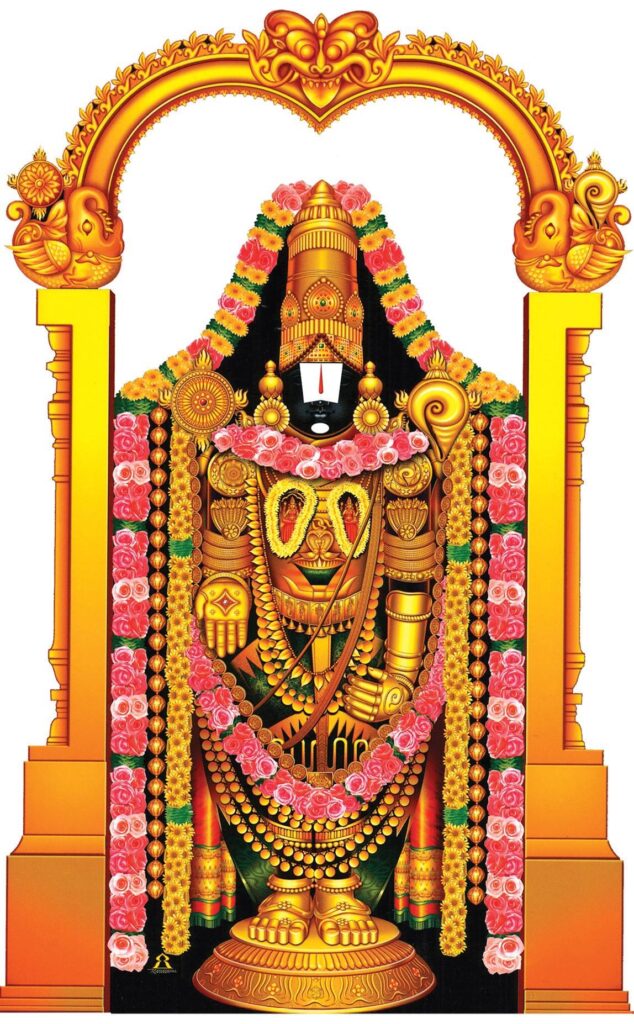
According to the Maya sastram however, “When the tip of the thumb is placed at the end of the breast, it is the attitude of abhaya or protection of God. If the hand is on the waist, it is said to be the attitude of giving vara or boon”. The Katyavalambita hasta pose is the one in which the Lord keeps his hand (left hand) on the kati or waist.
This is a pose that indicates that the Lord’s protection and grace are available to those worshipping him with constant devotion. According to another interpretation, it indicates that Samsara is knee-deep only to those devoted to the Lord’s feet.
Vishnu images are shown to carry several ornaments such as
- the Padma or the lotus,
- Kirita or the crown,
- Makara Kundalas or crocodile ear ornaments,
- Keyura or armlets,
- Kankanas or wristlets,
- Udarabandhas or ornaments around the waist,
- Katibandhas or ornaments around the waist and the hips,
- the sacred thread etc.
There is usually a mole on the right chest called the Srivatsa, and a garland reaching up to the knees called the Vaijayantimala. Sri Kaustubam is a gem-studded jewel on the chest which is sacred to Lakshmi. The consort of the Lord is usually carved or exhibited near the Srivatsa and the Sri Kousthubam.
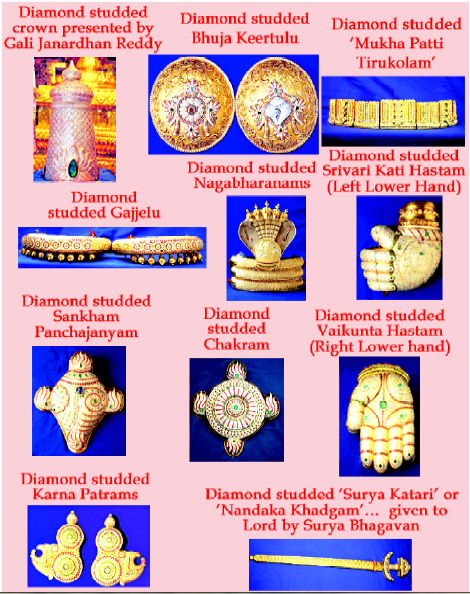
The Yoga murtis are depicted generally in the yoga mudra, and the sthanaka pose. The Lord has four arms with Sankha and Chakra in the upper two hands. The other two hands are in the abhaya and katyavalambita poses.
Yoga sitting idol is described in the Gherandasamhita as follows:-
“While squatting turn the feet upwards; place them on the knees; then place the hands on the asana with the palm turned upwards; inspire and fix the gaze on the tip of the nose.”
- A fine example of this pose is Sri Badrinarayana of Badrinath.
- The Sayana or reclining Yoga murti has only two hands of which the right is placed near the pillow under the head.
- The typical yogasana sayana murti is the image of Sri Ranganatha of Srirangam in South India.
- The Bhoga image of Lord Vishnu has also four arms with the Sankha and Chakra in the sthanaka pose.
- The hands are usually in the Abhaya, Varada, or Katyavalambita poses.
- As a Sayana murti, the Bhoga form is sculptured as seated in the sukhasana, in which the right leg hangs down and the left leg is folded to touch the right thigh.
- The reclining Bhoga murti has two or four arms and a well-built body.
- In this type Laxmi is depicted as seated near the shoulder of the Lord; Brahma near the naval of the main idol; and Bhudevi near the feet of the Lord.
- The Vira type of Vishnu image in the sthanaka pose is practically similar to that of the sthanaka yoga murti except that he stands alone or is surrounded by the sun, the moon, Brahma, and Siva.
- The sitting Vira murti is seated on a simhasana, with the left leg bent and the right leg extended in front.
- The reclining Vira murti has four arms of which one is used as a pillow and the other holds the Chakra with one of the left hands stretched out parallel to the reclining murti and the second left hand holding the Sankha.
- The Abhicharika variety is usually dark complexioned and the sculpture shows the angry pose to exhibit ugra rasa.
- The sthanaka image has two or four arms; the seated image has either two or four arms and is on an unornamented plain pedestal; the reclining idol is shown lying on the floor with two or four arms.
- The consorts of the Lord are not in attendance in this type of image, but the rishis and the demons Madhu and Kaitaba are shown in the act of supplication.
Thus we have in the agamas, three types, the sthanaka, asana, and sayana forms of the idol, each of which is divided into four classes namely Yoga, Bhoga, Vira and Abhicharika, each of which has also three grades of temples like Uttama, Madhyama, and Adhama. Thus there are 36 different types of Vishnu images out of which any particular image has to be specifically identified.
Seven Hills – Tirumala
Since the Lord is situated on a hill and in a forest where there was no village or fortresses in the earliest days, it should be either a Yoga Adhama sthanaka or Abhicharika sthanaka or Vira Adhama sthanaka murti. It is not likely to have been a Bhoga murti in those days. Since the temple has only one murti, it is an Adhama type.
The Yoga Adhama sthanaka type should have four hands with the two upper hands having the Chakra and Sankha, the right lower hand in the Abhaya posture, and the left lower hand in the Katyavalambita posture. The presence of Sri Devi on the chest is not mentioned in the Agamas.
The idol of the Lord Sri Devi is carved on the right breast as an integral part of the image and not one subsequently invested as a detachable addition. As against this rule, the lower right hand of the idol of the Lord is in the Varada Hastha and not in Abhaya Hastha while the Sankha and Chakra on the two upper arms are detachable and are not integral to the image. The image is therefore according to the agamic rules, not a Yoga Adhama sthanaka murti.
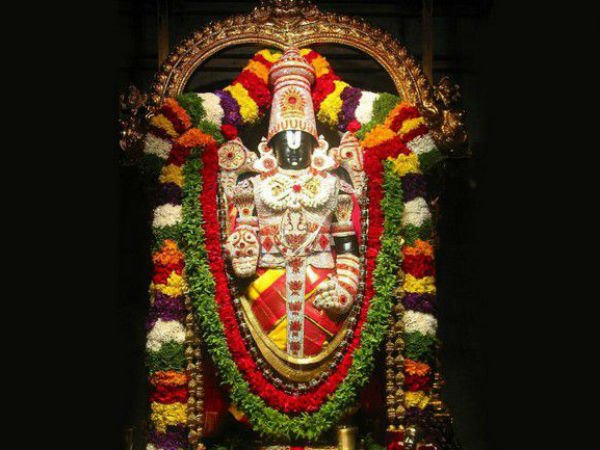
An Abhicharika sthanaka murti whether Uttama, Madhyama, or Adhama, might have two or four hands but without any of the divine weapons. The posture of the hands whether Abhaya, Varada, or Katyavalambita, is not laid down in the Agamas. Hence the image of the Lord could be of the Abhicharika sthanaka type but for certain other disabilities.
The Abhicharika murti should have a shrunken chin, and lean angas, that is, the hands, legs, and body are to be shown as lean and it should also have upturned eyes exhibiting thamoguna. The idol of the Lord at Tirumala is however an extremely lovely figure, having well-formed and well-proportioned angas and with all the divine ornaments associated with the description of paravasudeva and with Sri Devi, the eternal mother as an integral part of the image.
The image is therefore obviously not an Abhicharika sthanaka whether of the Uttama, Madhyama, or Adhama sub-divisions. The vira type of image should have a Sankha and Chakra permanently and Sri Devi is not mentioned as part of the idol.
Though the posture in the lower arms namely Varada or Abhaya is not specified, the presence of Sri Devi and Sankha and Chakra not being an integral part of the image, rule out this possibility also. As regards the Bhoga type of image, here also the Sankha and Chakra should be permanent and Sri Devi and Bhu Devi should both be permanently on the breast. The other hand should also be in the Katyavalambita simhakarana posture which is not seen in the image of the Lord. The only ingredient specified in this type of image is the Varada hastha position of the right lower arm.
Except that the Lord is Shyama or dark in color and has four arms of which two are detachable, the application of the Agamic rules establishes that the idol of Sri Venkateswara does not fall under any of the types which the Agamas prescribe for installing a Dhruva murti.
It only remains now to examine whether the Lord confirms the type of the Parabrahma or Para Vasudeva.
Different Samhitas describe Him differently in His Divyaloka. A short one given in Bhrigu Samhita (33rd Adhyaya) shows that
- He has four hands, and
- is invested with the five weapons or ayudhas;
- the two halves of His body are symmetrical and beautifully shaped;
- that he wears all the divya abharanas (jewelry); that Sri Devi ever abides in His Form and
- that He is full of all the Kalyana gunas and wanting in none, and that He shines with His six gunas (Shadguna).
This description is not a detailed one. The weapons (divya ayudhas) are not in Sri Venkateswara’s hands. The mention of the Shadgunas is worth noting. The Pancharatra Agamas describe Para Vasudeva in different terms, mostly as being seated on Ananta, the Divine Serpent. They are all out of place for a consideration of the problem here.
In the seventh chapter,
sixth amsa of Vishnupurana there is a description given of the Murta Rupa of Vishnu for purposes of meditation. Four stages of meditation are mentioned. In the lowest, the Murti is meditated upon as having all the weapons, all the bhushanas (ornaments), and with eight or four hands. In the next higher stage the meditation is upon the Murti, dropping out the divine weapons; in the next higher even the bhushanas or ornaments are also left out.
In the next higher only the principal angas such as the body, two hands, etc., are presumed to be seen.
This description states that the Murti has a
- Prasanna (spotless and brilliant) face, beautiful eyes shaped like the petals of the lotus flower,
- beautiful temples, broad forehead,
- Kundalas (ear ornaments hanging down the even earlobes),
- the kantham (or neck) shaped like the right-handed Sankham (Chank),
- broad chest with Sri Devi seated on the Srivatsa marks,
- Udara (or belly) in three folds as it were, a deep seated navel,
- long hands eight or four in number, well-knit and symmetrically shaped thighs,
- spotless pitambara clothing with ornaments such as Kiritam (crown),
- Haram (necklace) Keyuram (shoulder ornaments),
- Katakam etc., rings on the fingers and toes.
The ayudhams (weapons ‘in his hands) are Sarngam (bow), Sankham (conch), Gada (mace), Khadgam (sword), Chakram (disc). Akshamala (garland of beads) is in the sixth hand; of the remaining two hands one is in the Abhaya posture and the other in Varada posture.
When only four hands are meditated upon Sankham, Chakram, Gada and the lotus flower adorn them. The above description in full is of the form for the lowest stage of meditation. This description does not apply to the form of Sri Venkateswara.
In the next higher stage all the weapons are left out and the four hands would therefore be free. All the bhushanamas or ornaments however remain on the Murti. This description would apply to the Murti form of Sri Venkateswara in a general way. The lower hands have however a definite posture, the right Varada and the left Katyavalambita, and corresponds to a Murti for meditation in the second stage.
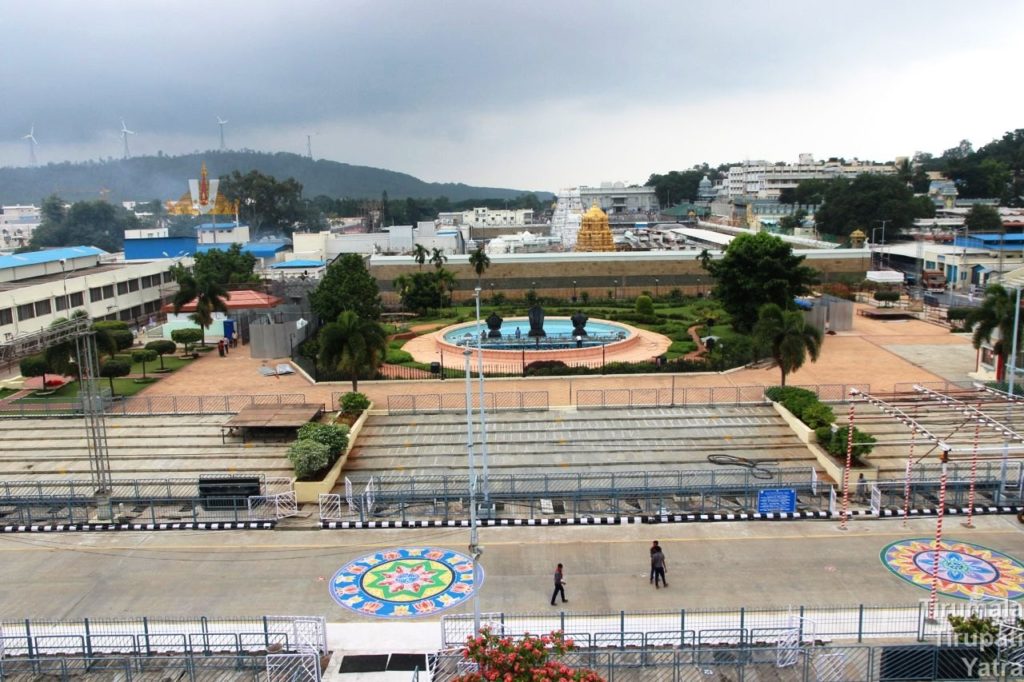
The idol of the Lord at Tirumala does not correspond to these rules also. From a detailed examination of the agamic rules, one can therefore only come to any of the two following conclusions.
(a) The idol of the Lord at Tirumala was conceived and executed at a time before the Agamas were codified and came into being, or
(b) The image is a class by itself and from the earliest days, has been so conceived and made by the sculptor, as to drive home the point that the Lord is self-manifest or Swayambhu.
